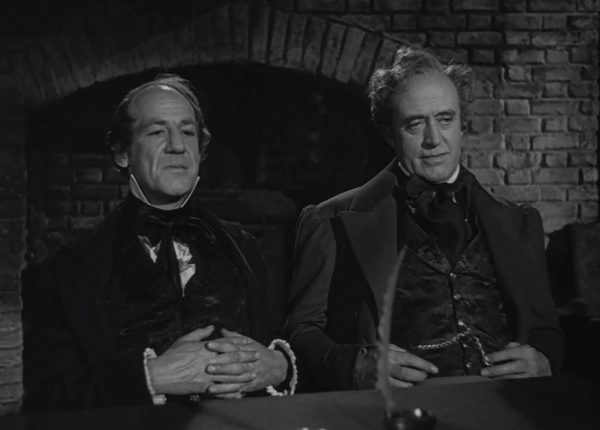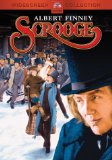There are few characters more associated with Christmas than Ebenezer Scrooge. You have to wonder if when Charles Dickens created the penny-pinching misanthrope, he had any idea of the longevity Scrooge would enjoy, or that of all of Dickens’ novels A Christmas Carol
would be the one most well known….and thanks to who? Scrooge. Which is why he is so deserving of this Scrooge character analysis.

Scrooge Character Analysis
What is it that makes Scrooge a character with such longevity? Let’s break him down a bit, but first a description of him in Dickens’ own words.
“…he was a tight-fisted hand at the grindstone, Scrooge! A squeezing, wrenching, grasping, scraping, clutching, covetous old sinner! Hard and sharp as flint, from which no steel had ever struck out generous fire, secret, and self-contained, and solitary as an oyster.”
Sounds lovely, doesn’t he? This low start, of course, makes Scrooge’s transformation all the more rewarding. He arcs and that, in a nutshell, is what makes him great. Watching Scrooge change from this very harsh beginning into someone who appreciates the people around him, and not just his money, is rewarding. We don’t read and re-read A Christmas Carol because we like the plot. It is, after all, a tad basic. We read and reread, and film and refilm, Scrooge’s story because we want to watch Scrooge change.
Now for the breaking down part…
When building a character of my own, I follow Nine Steps. Let’s fill them in for Scrooge.
Nine Steps to Building Character, or in this case, Analyzing Character:
- The first step is recognizing the character’s cloak or the mask. This is how the world sees the character. Dickens lets us know this right up front.
Scrooge is cheap and mean, but Dickens also lets us see that despite Scrooge’s harsh treatment of his clerk, Bob Cratchit, Cratchit doesn’t hate his boss. In fact, Cratchit defends Scrooge to his wife. This lets us know that there is hope for Scrooge. Cratchit is capable of seeing behind the mask that Scrooge has so carefully constructed. Scrooge wants people to believe his mask is real because it keeps people from getting close to him. But Cratchit isn’t fooled.
- The second step is the character’s fear. He uses the mask to hide this. And as I’ve already said, Scrooge works hard at hiding this fear.
Your average reader if asked what Scrooge’s fear is at the beginning of the book would probably say he fears losing his money–he is a miser after all. But even if this were true, it isn’t deep enough. Scrooge’s obsession with money isn’t his real issue. He just uses it to hide his real fear from others and himself.
So, what is Scrooge’s fear? Flip to the end of the story. What does the Ghost of Christmas Yet To Come show Scrooge that fills him with enough horror that he changes his ways? Does he lose his money…well, yes, but only after he is dead. So, he had his money right up to the end.
No, what the Ghost of Christmas Yet To Come shows Scrooge is Scrooge dying alone, unmourned and unimportant to anyone except the Cratchits who he has in many ways treated the worst. He has his money and his possessions, but he has nothing else. He has no one.
So, what is his fear? A little back story goes a long way to pinning down a character’s fear and Dickens gives us that with the first ghost, the Ghost of Christmas Past. “At one of these a lonely boy was reading near a feeble fire, and Scrooge sat down upon a form, and wept to see his poor forgotten self as he used to be.” Then the Ghost of Christmas Past takes us to Scrooge at school. “…that there he was, alone again, when all the other boys had gone home for the jolly holidays. He was not reading now, but walking up and down despairingly.”

The ghost even gives us a glimpse at a time when Scrooge was happy, first when his sister comes to school to get him and later when he is an apprentice in a job similar to what he does now. Was he surrounded by money? No, he was poor, but he was accepted and surrounded by people. He at that point belonged.
What the ghost doesn’t show us is what happened between this happy time and the next scene where Scrooge’s fiancé leaves him because he loves his money more than her. This is a bit of a gap, but we know from other parts of the book that somewhere in here Scrooge’s sister, the one person with whom he had a true relationship, dies while giving birth to her son, Scrooge’s nephew.
So, in my mind, Scrooge’s fear is of being alone and perhaps more specifically abandoned. He was abandoned as a child when his mother died during his birth. He was subsequently abandoned emotionally by his father who blamed Scrooge for his wife’s death. He was abandoned by his sister Fan when she died, and he was abandoned by his fiancé. (Even though Scrooge’s own actions pushed the fiancé away, he was still abandoned. Her actions just confirmed his fear even more.)
- The third step is the character’s strength which he uses as a crutch to cope with or cover his fear. This will be part of the mask. For Scrooge, his crutch is his ability to amass wealth. Focusing on this keeps him from feeling the bite of being alone. He also believes that he can, by hoarding, keep at least his money from abandoning him.
- The fourth step is the character’s motto. A motto is something a character might actually say in the book to another character. For Scrooge, I think it is “money matters.” If money matters then he doesn’t have to spend time on other things, like people.
- The fifth step is a characteristic the character admires in others. This can be a sneak peek at who the character will become at the end of his journey–after his arc is completed (assuming you aren’t writing a tragedy where the character chooses his fear over his true self). Who did Scrooge admire? His sister who Dickens describes as “brimful of glee.” She is open and loving and filled with hope for a father who had emotionally abandoned Scrooge at his birth.
- The sixth step is the character’s weakness. This is the characteristic that gets the character in the most trouble with his story’s antagonist. Scrooge is full of weakness, but the one that gets him in trouble with the antagonist (who is Scrooge himself), is his lack of empathy. Until he can feel empathy for others, others won’t feel empathy for him and he will remain alone.
- The seventh step is the character’s dark side. It is what the character could become at his worst. With Scrooge this is where we start the story. He is his dark side. A Christmas Carol is a story of redemption, a fine and somewhat common theme for Christmas stories. (The Grinch and It’s a Wonderful Life are two other examples.) In most genre novels today, however, the character doesn’t arc quite as fully as Scrooge.
- The eighth step is the character’s core need. This is what needs to be filled for the character to be his true and happy self. If this is filled he won’t need the mask any longer. Scrooge needs to feel the love and acceptance he felt with his sister, but more than that, he needs to realize that if someone leaves, he will still be okay.
- And finally, the ninth step is that true and happy self. What the character would be like with his core need filled and his mask and fear abandoned.
Dickens shows us this too. He gave us a peek early on with the flashback to the young Scrooge being greeted by his sister, but in the end, Scrooge is completely transformed. He chuckles and buys turkeys. He even goes to see the nephew he has avoided. He has more than completed his arc. And that from a modern perspective would be my only issue with the tale. Scrooge’s transformation is a bit over the top and probably not completely fitting with the character Dickens drew from the start.
But then it is Christmas…a time for miracles.
~~~

Lori Devoti is the author of paranormal romance, urban fantasy and young adult fiction. Under the name Rae Davies, she writes the USA Today Bestselling Dusty Deals Mystery series. Check our her books at www.LoriDevoti.com and RaeDavies.com. Looking for help with your writing? Lori also does developmental editing and critiques for other authors and publishers. See our Editorial Services page for contact information and pricing. Or check out Lori’s classes at the Continuing Studies Department of the University of Wisconsin.

Good post, Lori. Maybe Dickens meant to be over the top at the end of his story. He was writing at a time when great differences existed between the classes [kind of like now :)] and poverty was evident everywhere. Perhaps his over-the-top ending was meant as a gentle kick in the pants to his complacent readers.
Yes, it is hard to judge literature written in another century with today’s standards. Or maybe it isn’t hard, just not fair. :) And, as I said it is a Christmas story. Even today that equals more allowance for over-the-top.
Thanks for commenting.
Hi, Lori!
Scrooge’s fear is most certainly that of being abandoned. If he feared being alone, he would do anything to avoid being alone. And yet, he lives totally alone by choice. So that can’t be his fear.
That’s why I believe he fears abandonment–loving someone and losing them. His life has taught him that if he doesn’t care about other people, he won’t get hurt when he loses them. He cares about money instead. He knows how to control money. But he still fears his wealth will also abandon him, and that’s why he goes to great pains to avoid losing it.
This a great and in-depth discussion. I always love talking character with you!
This is a great post, Lori (and yeah, the over-the-topness of the ending is also one of the reasons it endures, I think). Great illustration of character. Thanks!
Hi Lori. Well its nearly that time of the year again.
Some excellent observations on Scrooge.
I also feel the the somewhat complexed character reflected the mean & uncaring attitude of the day & in some respects they are both visible in the current climate.
But back to the story, with a different slant. I felt sympathy for the man & his family problems.
As for the rest of society he saw them as brain dead consumers, much like today, & furthermore he did begrudge them their brief bit of happiness in such awful times (1840s).
Bah humbug and a good day to you sir.